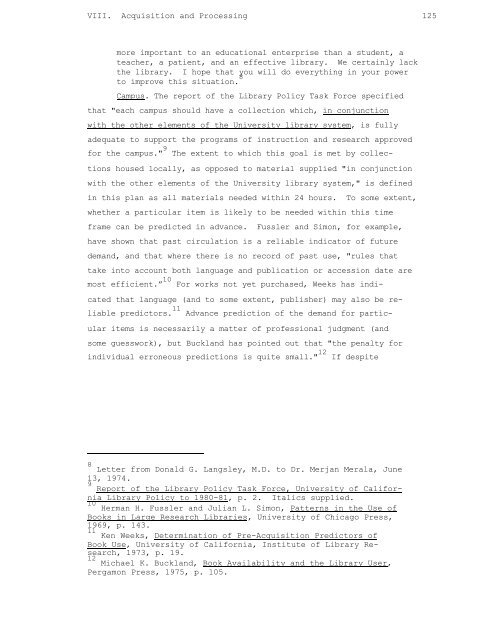The University of California Libraries: A Plan for Development (1977)
The University of California Libraries: A Plan for Development (1977)
The University of California Libraries: A Plan for Development (1977)
You also want an ePaper? Increase the reach of your titles
YUMPU automatically turns print PDFs into web optimized ePapers that Google loves.
VIII. Acquisition and Processing 125<br />
more important to an educational enterprise than a student, a<br />
teacher, a patient, and an effective library. We certainly lack<br />
the library. I hope that you will do everything in your power<br />
to improve this situation. 8<br />
Campus. <strong>The</strong> report <strong>of</strong> the Library Policy Task Force specified<br />
that "each campus should have a collection which, in conjunction<br />
with the other elements <strong>of</strong> the <strong>University</strong> library system, is fully<br />
adequate to support the programs <strong>of</strong> instruction and research approved<br />
<strong>for</strong> the campus." 9 <strong>The</strong> extent to which this goal is met by collec-<br />
tions housed locally, as opposed to material supplied "in conjunction<br />
with the other elements <strong>of</strong> the <strong>University</strong> library system," is defined<br />
in this plan as all materials needed within 24 hours. To some extent,<br />
whether a particular item is likely to be needed within this time<br />
frame can be predicted in advance. Fussler and Simon, <strong>for</strong> example,<br />
have shown that past circulation is a reliable indicator <strong>of</strong> future<br />
demand, and that where there is no record <strong>of</strong> past use, "rules that<br />
take into account both language and publication or accession date are<br />
most efficient.” 10 For works not yet purchased, Weeks has indi-<br />
cated that language (and to some extent, publisher) may also be reliable<br />
predictors. 11 Advance prediction <strong>of</strong> the demand <strong>for</strong> partic-<br />
ular items is necessarily a matter <strong>of</strong> pr<strong>of</strong>essional judgment (and<br />
some guesswork), but Buckland has pointed out that "the penalty <strong>for</strong><br />
individual erroneous predictions is quite small." 12 If despite<br />
8<br />
Letter from Donald G. Langsley, M.D. to Dr. Merjan Merala, June<br />
13, 1974.<br />
9<br />
Report <strong>of</strong> the Library Policy Task Force, <strong>University</strong> <strong>of</strong> <strong>Cali<strong>for</strong>nia</strong><br />
Library Policy to 1980-81, p. 2. Italics supplied.<br />
10<br />
Herman H. Fussler and Julian L. Simon, Patterns in the Use <strong>of</strong><br />
Books in Large Research <strong>Libraries</strong>, <strong>University</strong> <strong>of</strong> Chicago Press,<br />
1969, p. 143.<br />
11<br />
Ken Weeks, Determination <strong>of</strong> Pre-Acquisition Predictors <strong>of</strong><br />
Book Use, <strong>University</strong> <strong>of</strong> <strong>Cali<strong>for</strong>nia</strong>, Institute <strong>of</strong> Library Research,<br />
1973, p. 19.<br />
12<br />
Michael K. Buckland, Book Availability and the Library User,<br />
Pergamon Press, 1975, p. 105.
















